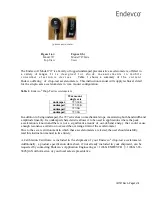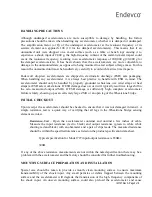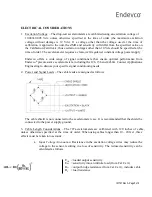
IM727 Rev A, Page 4 of 9
®
unwanted static strain, resulting in possible zero shift during a shock measurement. The surface on
which the accelerometer is mounted should have a surface roughness of 32 micro inches rms or
better and a surface flatness tolerance of 0.0003”.
For use up to 60
o
C: Aremco Crystalbond
TM
509 is recommended, following this mounting procedure:
o
Apply a moderate amount of Crystalbond
TM
509 on the bottom of the Model 727 accelerometer
o
Use a toothpick and spread the wax to form a thin, uniform layer covering area of contact, and
immediately position accelerometer on mating surface
o
Press down and hold accelerometer firmly in place for 30 seconds while the wax sets. Allow wax
to set for at least 1 minute for maximum strength.
Cyanoacrylate (super glue) is not recommended as a temporary adhesive unless an appropriate solvent
(such as acetone) is used to weaken the glue joint before attempting to remove the accelerometer. The
solvent should be swabbed around the base of the accelerometer; under no circumstances should the
accelerometer be soaked or immersed in any liquid. Similarly, if wax is used as a temporary adhesive,
always remove the unit using the appropriate amount of heat. Trying to remove the accelerometer by
shearing or twisting will excite the resonance and could cause permanent damage to the accelerometer.
Mounting to low strength material (such as aluminum) is not recommended. Additionally, adhesive
must always be used between the transducer and any low-strength mounting surface.
CABLE HANDLING
The 727 series of drop-test accelerometers are supplied with integral cables, which are terminated
in pigtails. The user can select an appropriate end-connector.
There are two important considerations regarding the integral cable when installing the
accelerometer. First, since the cable will be exposed to the same high level shocks as the
accelerometer, care needs to be taken to prevent damage to the cable. Relative motion between the
cable and the accelerometer can cause cable failure and/or a significantly shortened life. Second, the
signal voltage on the leads of the cable will be at a very low level and any excessive movement of
the cable could cause noise on the signal lines. Because of the above factors, it is important that the
following cable recommendations be observed.
If possible, the mounting preparation should allow for the cable to be routed perpendicular to the
primary shock direction to reduce the amount of tensile stress on the cable. To strain relieve the
cable close to the accelerometer, form a small bend (~¼” radius) in the cable within two inches of
the case and then tack the cable to the mounting surface with tape. Next, completely secure the cable
between the accelerometer case and the tape to the mounting surface by encapsulating with a
silicone RTV. A recommended silicone RTV is Loctite® item number 37463, an air curing RTV
which will be tack-free in 15-20 minutes, test-ready in roughly an hour and fully cured in 24 hours
(assuming 70ºF and 50% relative humidity). In routing the remaining portion of the cable to the
signal conditioner, it is important that there be sufficient slack in the cable, i.e. the cable should not
be pulled tight between the test specimen and the signal conditioner.



























